Existing User Log In
New User Registration
Register for a free account to gain full access to the VGChartz Network and join our thriving community.



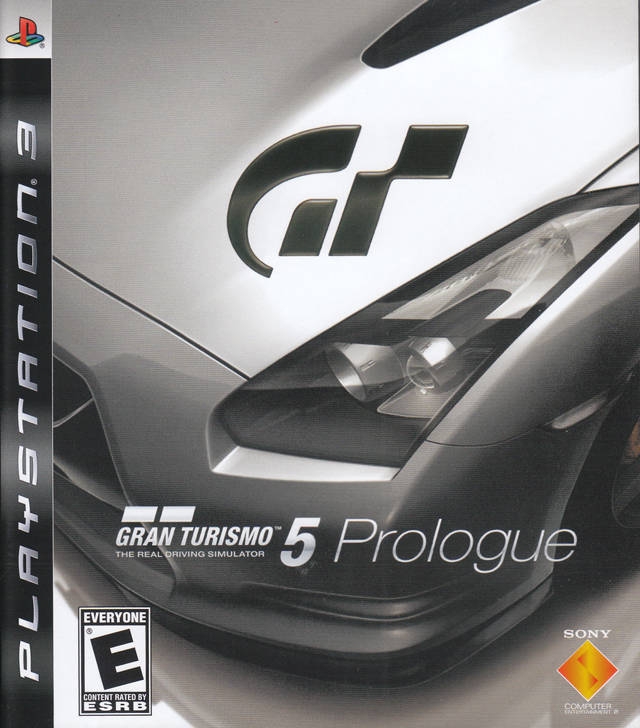

America - Front
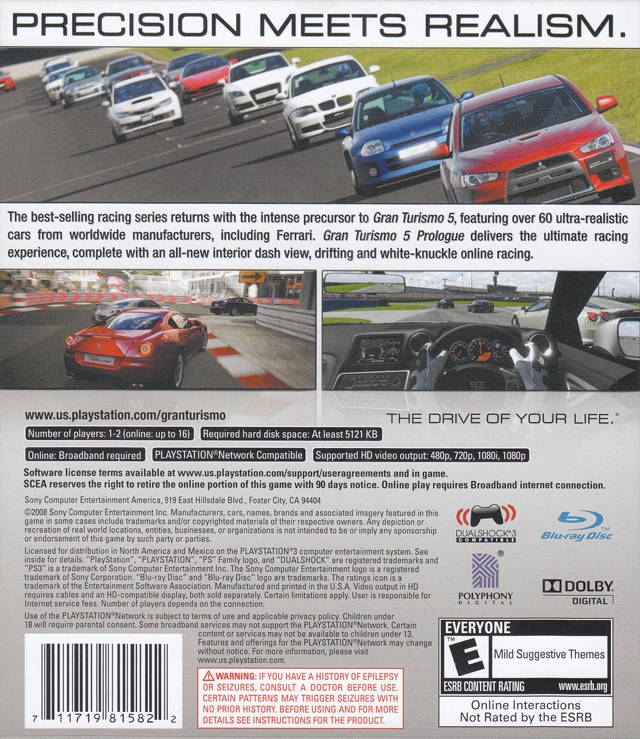

America - Back

Gran Turismo 5: Prologue (now referred to as Gran Turismo 5: Prologue Spec III after its most recent software update) follows in the footsteps of Gran Turismo 4: Prologue, and offers a taste of the next full Gran Turismo game, which still appears to be some way off. Whilst the amount of content on offer is nowhere near what we will expect to see from the full game, there is nonetheless a lot on offer in Prologue. Featuring more than 70 amazingly detailed cars, six tracks (with variations bringing the total track count to 12), 16 car races, several game modes, offline split-screen multiplayer and online multiplayer, Prologue is certainly more than just a demo, as you would expect given that you are paying for it.
Your ‘My Page’ is the main menu screen. It’s a really slick interface, with a world map and your selected car taking up most of the screen. The car is always set against a stunning 3D environmental backdrop, which can vary from lush green fields to quaint stonework plazas. From here you access all of the content in the game. Some of the extra content probably won’t appeal to most people, like the News, Rankings and GT-TV (the game’s HD video service) sections, but they add to the feeling of prestige you always get with a Gran Turismo game. You can view all of your cars from your Garage, and purchase new ones with your credits from the Dealerships.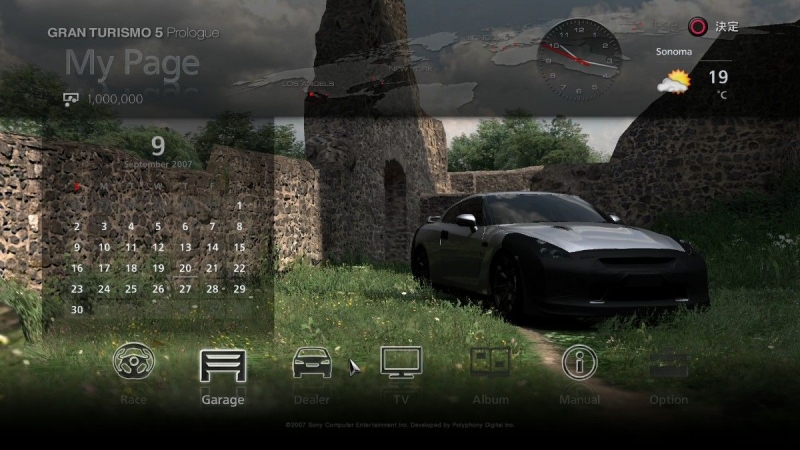
The Event mode is the game’s main mode (more on the other modes towards the end of the review), and it’s essentially a career mode spanning a total of 40 racing events set out across four different licenses. You start off by competing in relatively slow and easy Class C License events, which feature everyday budget cars, and then work your way up through Class B and A, before unlocking a bonus Class S, which features some of the most high-powered cars in the world. You earn credits by winning your races and completing your objectives in each class, and with those credits you then buy more vehicles from the dealerships, which in turn enables you to compete in the higher Class events that you unlock as your progress through your career. Most of the events in each Class are essentially standard races against other AI controlled cars, but a couple of other racing types are also introduced which add a little variety. There are time trials races and laps, which are pretty self explanatory, and there are also one-off challenges where you have to overtake the entire racing field within a single lap using a specified car.
As I mentioned in the introduction, there are over 70 cars available for purchase in the game, and they come from a wide range of manufacturers, including Suzuki, Ford, Aston Martin, Lexus, Dodge, Ferrari, and so on. There’s even a Ferrari F2007 Formula 1 racing car available to purchase, but it has a rather hefty price tag of $2,000,000, so it’ll take a fair bit of career grinding to unlock.
There are six tracks in the game. These are: the iconic High Speed Ring that is now a staple of the series, the Eiger Nordwand track that was used in Gran Turismo HD Concept, a beautiful London track (although it's woefully underused in the career mode), the two Japanese Forumla 1 tracks - Fuji International Speedway and Suzuka Circuit, and finally the Daytona International Speedway, a famous NASCAR track. Each of the six tracks also has a second layout, which means that the track count is effectively doubled to 12 (six unique track settings, 12 track layouts). For example, the London, Eiger and High Speed Ring tracks are also available in reverse, whilst the Fuji, Daytona and Suzuka tracks come in completely different layouts. Either way the alternative layouts really do make these tracks feel completely different, which adds essential variety to what would otherwise be a far too repetitive experience.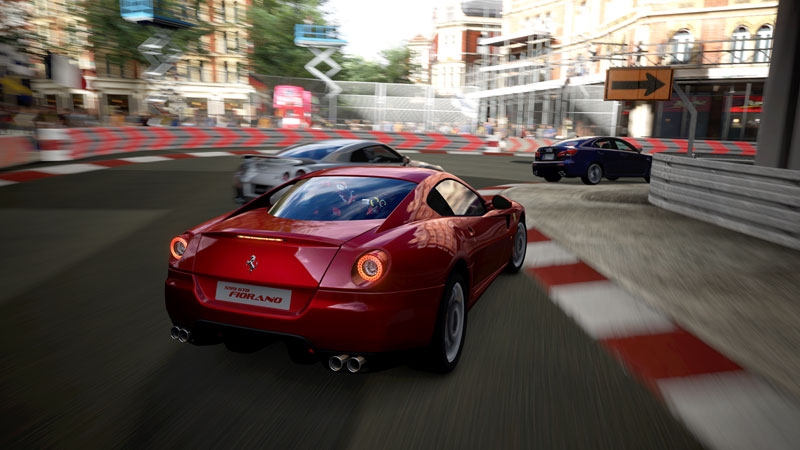
The Gran Turismo series is probably the most iconic simulation racer in gaming, and Prologue should only build upon that reputation. Fans of the series will almost certainly find the updated gameplay as immersive as ever, with each car having its own unique feel and sound, which is based on extensive work with the real cars. Unlike Gran Turismo HD Concept, where I always felt like I was crawling through the corners, Prologue offers a much greater sense of speed and immersion. There are also car tuning adjustment options, which you unlock after completing a core part of the Event mode, although the level of customisation available is quite limited.
There are two things I feel detract from the otherwise superb gameplay though, and they’re problems that generally plague not just the Gran Turismo series, but also the simulation sub-genre of racers as a whole. That said, Prologue does make some progress in respect of both problems. The first is the perennial problem of the lack of both damage modelling and physics. My complaint isn’t so much the lack of visual damage on the cars – bits and pieces flying off, windscreens being smashed etc. – as that’s where some of the more arcade orientated racers excel, the problem is more so the lack of immersion (and by extension, lack of simulation) involved in the absence of damage physics, whereby cars will just shunt together like bumper cars, and you can use other vehicles to supplement your braking (or lack of) through corners.
There are some rather loose assurances that this area of the game will receive a substantial overhaul come the release of Gran Turismo 5, but in the meantime Prologue offers the apparently temporary solution of introducing penalties for contact (and thereby avoiding the need for damage physics altogether), so if you attempt to use another car as a barrier to sling shot through a corner your engine cuts out for a set amount time. It’s only introduced later in the game, and for good reason. It serves as an effective deterrent against intentional contact and using other cars as brakes, but the problem is almost any contact is penalised, intended or not, and more importantly regardless of who initiates the contact. So you can be penalised for contact when it’s actually the fault of the AI controlled car for ramming into you. That can obviously make for some quite frustrating moments, but I did actually like the system and the way it was introduced. Reserved for the more the difficult races, it meant that game really did become more challenging as I progressed through the career, and where any contact is penalised you become quite neurotic about when and where to pass other vehicles, which certainly makes the game more life-like.
The second shortcoming is the AI. AI controlled cars in Gran Turismo games famously form long single-filed convoys, they never make mistakes, they stick doggedly to the racing line, and instances of overtaking are extremely rare. They completely lack character and personality and this has made the series feel quite artificial at times. So has this changed with Prologue? Well, kind of. On the one hand the AI controlled cars still generally stick to a set racing line and the field does still have a tendency to feel like a convoy of cars on their parade lap. On the other hand they feel more aggressive in their attempts to overtake and will sometimes push too hard into corners and will swerve off the track or spin out, which is a nice touch, though it does feel a bit too staged.
Presentation is undoubtedly Prologue’s strong point and in many respects this is the best looking PS3 game to-date, and the best looking racer on the market. The level of detail to be found in the car models is currently unrivalled. Each car looks almost photo-realistic. The most noticeable aspect of this is the introduction of an in-car camera view to the series. These in-car views are absolutely stunning, with every little detail for every single car being meticulously re-created, from the stitching in the leather to the precise dashboard layout. Even the back seats for each separate car have been detailed, so that when you access the rear view from inside the car you look out of each car’s real-life back window, complete with the precise detailing from the windows, rear shelf and seating areas. The in-car view also features fully functioning speedometers, wing mirrors and gear changes that really immerse you in the experience.
The tracks are also well detailed. The sunlight floods the screen as you exit a dark tunnel and it takes your eyes a short while to adjust, and the use of lighting in general is excellent. The crowds are fully 3D and well animated and the textures of the track surfaces really stand out. The London track is particularly notable, with narrow street roads and towering buildings that partially block the sunlight and cause it to scatter the road, and it contrasts well with the Eiger track and its beautiful wide open panoramic views stretching out for miles.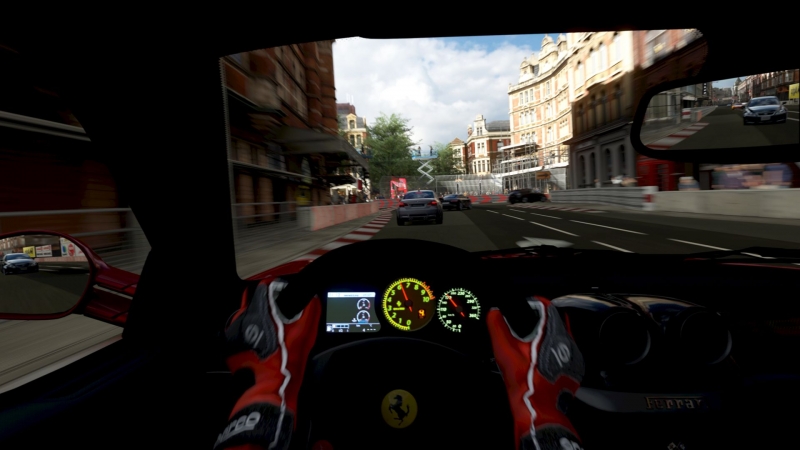
What’s particularly impressive about the graphics is not just the level of detail in the cars, their interiors and the environments, but that there isn’t a single technical issue in sight. The game runs at a stable 60fps, with no hint of screen tearing or slowdown to detract from the visuals. The graphics aren’t perfect though, as I mentioned earlier there is no damage modelling, and curiously you don’t leave real-time tire marks on the track, which is a little odd.
The menu music consists of car showroom jazz, whilst the in-game music is low-key rock music that makes for pleasant background music. As far as sound design goes the real star of the show is obviously the sound effects, and in particular the engine noises. Recorded using the real cars, each car has its own truly distinct engine sound, and it’s another area of the game’s presentation that really shines.
As well as the career-based Event mode I detailed above, the game also features a series of additional modes that add to the game’s value for money. First of all there’s a standard Arcade mode, which allows you to tweak the options and compete in a single race against the clock or against up to 15 AI controlled cars. Secondly the Drift mode from Gran Turismo HD Concept makes a return. As the name implies, this mode challenges you to race around the track trying to string together drifts for as long as possible whilst racking up points. Thirdly there is an offline splitscreen multiplayer mode, and finally there is an online multiplayer mode for up to 16 players in each race.
Online multiplayer closely mirrors the races found in the latter stages of the Event mode, with specific parameters set out for each race and credits awarded based on your performance. The online interface is satisfactory, if a little confusing for newcomers, but the whole online experience very much feels like a dry run ahead of Gran Turismo 5. Whilst your experience will generally be very smooth and lag-free, opponent cars can sometimes be quite jerky and can flicker around the track, particularly around the busy corners. Prologue also opts for an anti-collision mechanism that a lot of simulation racers adopt online, whereby erratic movements against other players will cause nearby cars to become ghosts, and you’ll pass straight through them.
Races begin with a rolling start, but unfortunately this means that the person starting in 1st will be a considerable distance ahead of those starting at the back of the field because the distance between the cars on the starting line is the same as it is in single player. This means that those starting at the back of the grid stand little to no chance of winning the race unless the players at the front of the grid are particularly bad or just happen to make a mistake. The online multiplayer could certainly use some work ahead of the full game, but the inclusion of online multiplayer is certainly a welcome bonus.
Gran Turismo 5: Prologue is a good preview of what we can expect from the full game when it eventually releases, but it’s also a solid game in its own right, with enough content, precision and attention to detail to challenge a lot of full priced racing games currently on the market. Prologue is a great example of what the Gran Turismo series is famous for, all in a small budget-priced package.










|
|
|
|
|
Kerotan
posted 11/08/2016, 01:29
Confirmed as over 5m! http://gamrconnect.vgchartz.com/thread.php?id=219397&page=1 Message | Report |
|
|
JustThatGamer
posted 20/10/2013, 04:39
This game is almost as under-tracked as God of War III, both by well over 1 million units! Message | Report |
|
|
|
|
|
|
|
|
|